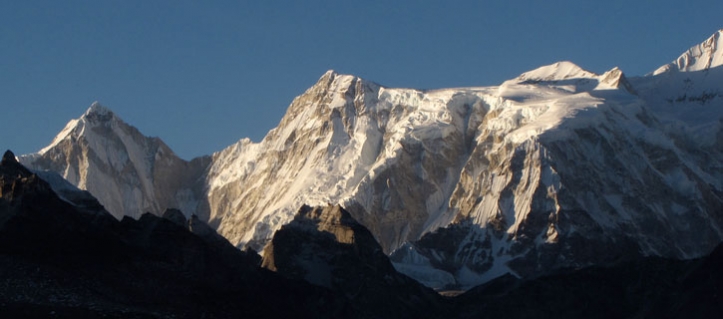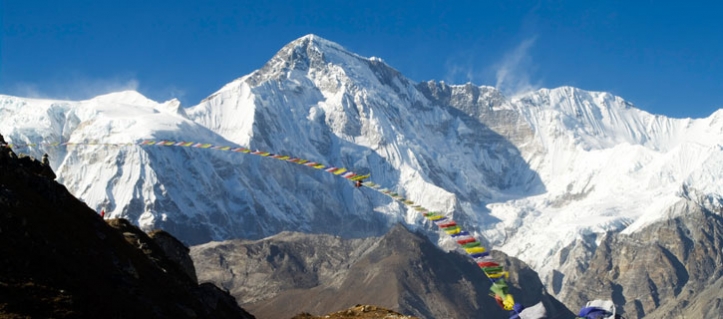BackPacking Bhutan |
 |
|||||||||||||||||||
|---|---|---|---|---|---|---|---|---|---|---|---|---|---|---|---|---|---|---|---|---|
| Hot Line : 03-40248896 or 016-6375622 | Enquiry:
goalus@mymountaingoal.com |
|||||||||||||||||||
Mountain Goal Adevnture Activities:-
|
Cho Oyu Expedition – 45 days |
|||||||||||||||||||
Mountain Background For anyone who has ever dreamed of climbing one of the world's highest 8000er mountains, Cho Oyu offers relatively easy access. Despite being the 6th highest mountain on the planet, Cho Oyu has the highest success rate among the world's fourteen 8,000er Himalayan peaks. The ascent to the summit is short and direct with a few small technical sections which can be climbed safely using fixed lines. The normal route may not be called a technically difficult climb. The access becomes easier also because of the fact that the mountain can be reached by four-wheel-drive vehicle and one can walk to the Camp 1 in hiking boots. However, climbing Cho Oyu is still a demanding undertaking, the mountain being one of the highest on earth.
Important Note and Optional Activities
Detailed Expedition Itinerary
What is included
What isnot included
Recommended Previous Experience Although Cho Oyu is considered to be less technical than other 8,000ers, it's simply not a piece of cakewalk to climb Cho Oyu. It's also true that getting back from the summit is more important than getting there. The oxygen level over 7,000m is only 40% of what it is at the sea level. The weather is never fully predictable. The climbers must have years of prior experience on rock and ice climbing especially above 7,000m. You also need to feel confident and comfortable ascending or descending on fixed ropes along a steep technical terrain. Moreover, as Jon Krakauer says, while you're Into the Thin Air up there, “The consequences of a poorly tied knot, a stumble, a dislodged rock, or some other careless deed are as likely to be felt by the perpetrator's colleagues as the perpetrator.” Your actions affect not only your own, but welfare of the entire team. Insurance It is a condition of joining any of our trips that be protected against comprehensive expenses potential to incur due to medical issues or accidents (to include air ambulance, helicopter rescue, and treatment costs). Please be noted that we don't arrange or sell insurance. Catering Arrangements We provide all camping equipment and gear, including tents, dining, toilet, and Kitchen tents. At base camp we have a large mess tent equipped with all necessary kitchen gadgets including stoves, tables and chairs. Meals are prepared by our trained and experienced expedition cooks. We make it sure that the food we provide is hygienic and at the same time suits your palate. We offer all varieties of food including continental and local Nepali/Tibetan items. Breakfast includes porridge, egg, bread, etc. Some of the items in the lunch include rice, lentils, beans, green vegetables, chapattis, bread, and tinned meat and fish items. Fresh or tinned fruit and tea or coffees make the desserts. For the main meal, you can choose your own menu - either local or western varieties. Local varieties include from the local Dal Bhat, yak stew, momo to the western burghers, pastas, sandwiches, and pizzas. During the actual mountain climbing, we mostly use dry or dehydrated foods, including chocolate, cheese, nuts, and muesli items. Information about Visa and Travel Permits Aside from visas for China, travelers to Tibet must also obtain permits from the Tibetan Tourism Bureau. Himalayan Glacier Trekking will organize your Tibet travel permit. Please send copy of your passport if you are planning to enter Tibet via Nepal as soon as you book the trip. In the condition you are planning to enter Tibet via China; you need to send us copy of your passport and Chinese visa as soon as you book the trip. Trekking Day A typical trekking day starts at around 6 or 7 am. Enjoy the hearty breakfast and begin trekking. Carry your pack containing personal items you need for the day. The porters and yaks carry all the loads. Walk at your own pace, enjoy the scenery, chat with the natives, and take photographs. The lunch time depends upon the terrain and is prepared by our catering team. Generally you stop for lunch after about 3 hours of walking. The lunch hour also helps in acclimatization. The aim would be to reach next stop by the sunset. After reaching the overnight stay point, the crew members fix the tents. You may relax with a cup of tea or coffee or take a pleasure walk around the camp site. The dinner would be ready around 7 PM. Enjoy the dinner while sharing the day's experience with team members. Climbing Day The climbing itinerary may vary according to the climber's personal experience. A climbing day involves a steady climbing for 3-4 hours in the morning. After taking lunch, rest and relax, there is a climb of 2-3 hours in the afternoon. However, flexibility in climbing itinerary is necessary as people climb at own pace and respond individually to the stresses of climbing. We ensure the ratio of climbers and Sherpa guides focusing on high safety measures so that each individual climber is able to progress at their own rate. The Climb The Base Camp ( 5,200 m/17,500 feet) Follow the regime "climb high, sleep low". Being below the snowline at 5700m, the weather at Base camp is generally good. It gets cold at night with dry but changeable wind conditions. There is no vegetation at this point and no human habitation. Take acclimatization hike before attempting further up. Head to Advance Base Camp (ABC) the next day. Forge through the ice cold Ra Chhu River and set up intermediate camp. The following morning trek to ABC ( 5700 m) and camp next to the Nangpa La. Base Camp to ABC to Camp 1 (6,400m/ 20000ft): ABC lies at 5700m surrounded by high peaks. There is also the high pass called Nangpa La nearby which has been used since a long time as a yak track & trade route between Nepal and Tibet. ABC will serve as the main base camp for the rest of expedition. From the ABC, there will be several hours of walking over moraine-covered glacier. One can walk to the Camp 1 in hiking boots! Camp 1 lies on a ridge at 6400m which is soft and easy for climbing in the beginning. Camp 1 to Camp 2 (7,000 m/ 22960 ft) Actual mountaineering begins from Camp 1.The ridge broadens out, fix a rope up whenever necessary. The route is crevassed at places not much difficulty. The route follows the Northwest ridge, and then opens out onto the Northwest face of the upper mountain. Most of the route between Camp 1 and 2 will be fixed with rope. The most technical section is the ice cliff at 6750 m / 22,145 ft which consists in a near vertical 60º to 70º slope for 50 m. Most of the route between Camp 1 and 2 will be fixed with rope. Above there lies a large plateau leading to the last step slope below the Camp 2. Camp 2 to Camp 3 (7,400 m/24272 ft) From Camp 2, you can see the base camp below and a bunch of 7000 m peaks. Further east lies the Shishapangma. Camp 3 is located at the height of 7,400m. Some climbers even attempt the summit from Camp 2. However, it's always better to assess your condition before getting tempted. Camp 3 is established at about 7450 m (24,500 ft) to maximize the chance of success on summit day. Camp 3 to Summit Depending upon season and weather, it may be cloudy, snowing, or high wind. Start early in the morning from camp 3. The first obstacle is the "Yellow Band" usually fixed with rope. More rocky bands and steep snow put the climbers on the summit ridge snowfield. Continue up the steep snowfield to the crest of the Northwest Ridge and the false summit. cross a broad plateau, with a very small rise to the true summit A breathtaking panorama unfolds as we get to the summit with the magnificent views of Everest , Lhotse, Nuptse, Chamlang, Ama Dablam and many other Himalayan peaks. Descend to Camp 2 from summit and continue down to the ABC. Weather Conditions The springtime from March to May and the Autumn months from September to November is considered the favorable weather for Cho Oyu climbing. However, the weather conditions in high mountains are never fully predictable. Temperatures may get as low as minus 20C in summer, but can drop to minus 60C or even lower during winter. The possibility of bad weather such as snow, wind, and cloud should also be taken into account. Similarly, the wind speeds may rise to 80Km/h (50mph). At the Base camp the temperature is about 15C warmer than at the summit. The oxygen level around 7,000m is only 40% of what it is at the sea level. Leadership Our Cho Oyu expeditions are led by experienced and professional mountaineers and guides who have scaled the mountain several times supported by other crew members and all the necessary logistics for the expedition. Not only in terms of qualification, but we also make it sure that our leaders have proven track of record in climbing high altitude mountains. The number of guides is chosen according to the team size to maximize every individual climber's chance of making it to the summit without compromising the safety aspect. Our expedition leaders are also equipped with the expertise in handling altitude related problems including acute mountain sickness (AMS) symptoms. The crew members are experts in setting up tents and camps, melting snow on the route, cooking, and other daily needs. Team Composition Team composition is important to ensure safety and comfort of the climbers. We observe high safety standards, therefore, for 2 International Climbers, we assign: MMG Accredited Climbing Leader High Altitudes Assistance Sherpa Cook Base Camp Assistance and other necessary trek crew such Porters, Yaks and Yak man Because of our high safety standards, team members would be added as per the number of international climbers. Best Season The spring season of March to May and the Autumn season of September to November is considered the best time for Cho Oyu expedition. The months of April and May and then again October and November are the classic climbing period. The summer months of monsoon rains and the winter months from December to February are considered to be the most unfavorable time climbing.
|
||||||||||||||||||||
|
||||||||||||||||||||
Copy
Right by Mountain Goal Adventure Consultant. |
||||||||||||||||||||


